Trap Crops And Dynamic Accumulators – The Flowers You Should Be Planting With Vegetables

Reviewed By ROY NICOL

Roy is a Professional Gardener and Horticultural Consultant, specialising in large garden year-round maintenance and garden development. He is an RHS Master of Horticulture and uses his research in the application of no-dig methods in ornamental garden settings. Roy has been a Professional Gardener for more than six years and is a member of the Chartered Institute of Horticulture, Professional Gardener's Guild and Association of Professional Landscapers (Professional Gardener).
If you’re growing vegetables in your garden, you might be wondering which flowering plants would work well if grown next to them.
Growing flowering plants as companions to vegetables can offer a range of benefits, which, depending on the plant, can include:
- Boosting pollinator numbers
- Deterring pests such as aphids and spider mites
- Acting as ‘trap crops’ by attracting pests that will then ignore your vegetable crop
- Providing beneficial nutrients – either as dynamic accumulators, or as fertilisers which can be turned into ‘tea’ or ‘chopped and dropped’
- Offering shade or beneficial soil conditions through their foliage or roots
In this guide, we share fifteen plants that will provide some or all of these benefits in your vegetable plot:
1) Comfrey
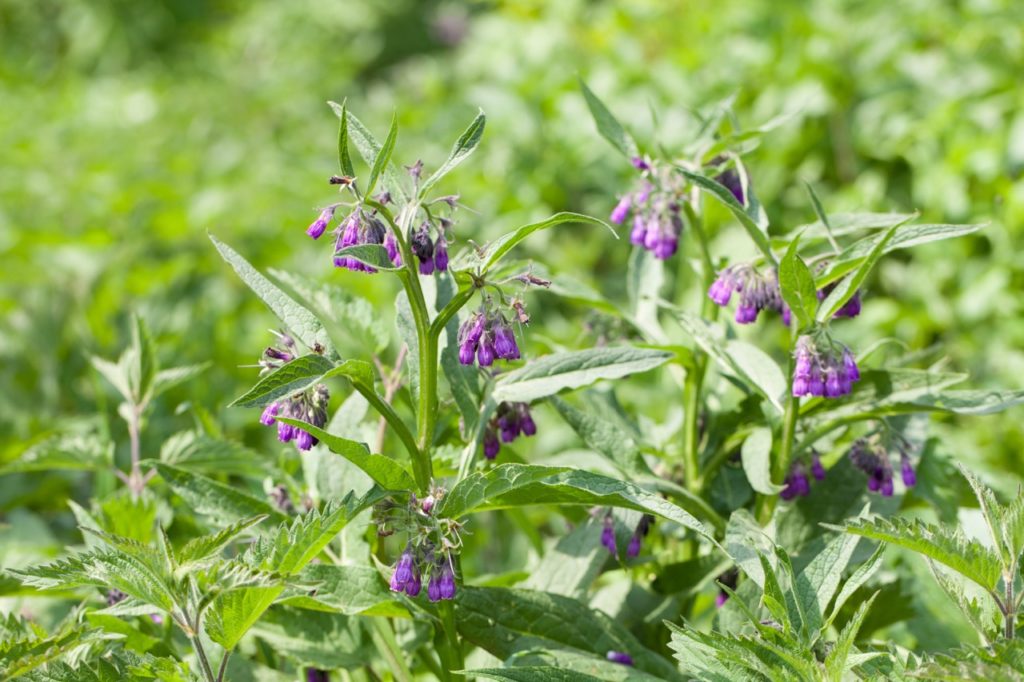
- BOTANICAL NAME: Symphytum officinale
- HARDINESS RATING: H7
- PLANT TYPE: perennial
- FLOWERS: pink, purple and creamy yellow
- FLOWERING SEASON(S): spring / summer
Symphytum officinale, or comfrey, is a highly beneficial plant to grow with your vegetables.
Although often grown as a stand-alone perennial, comfrey makes a great addition to a vegetable garden, as when it flowers, it can attract a range of pollinators to your garden.
It is a favourite of Permaculture gardeners due to the many holistic benefits it provides in the garden.1Abel, A. (2020, May 22). How Permaculture Practices Can Help You Mentally and Physically During Isolation. The Permaculture Research Institute. Retrieved March 15, 2023, from https://www.permaculturenews.org/2020/05/22/how-permaculture-practices-can-help-you-mentally-and-physically-during-isolation/
Growing comfrey means you can harvest the leaves to make comfrey tea, which can be used as an organic fertiliser for the plants in your vegetable patch that love potash – like tomatoes for example.
There are endless benefits to growing comfrey varieties next to your vegetables, but keep in mind that this plant can grow quite large, so be sure to keep it in check by cutting back regularly – ideally before setting seed as Comfrey is a prolific self-seeder.
2) English Lavender
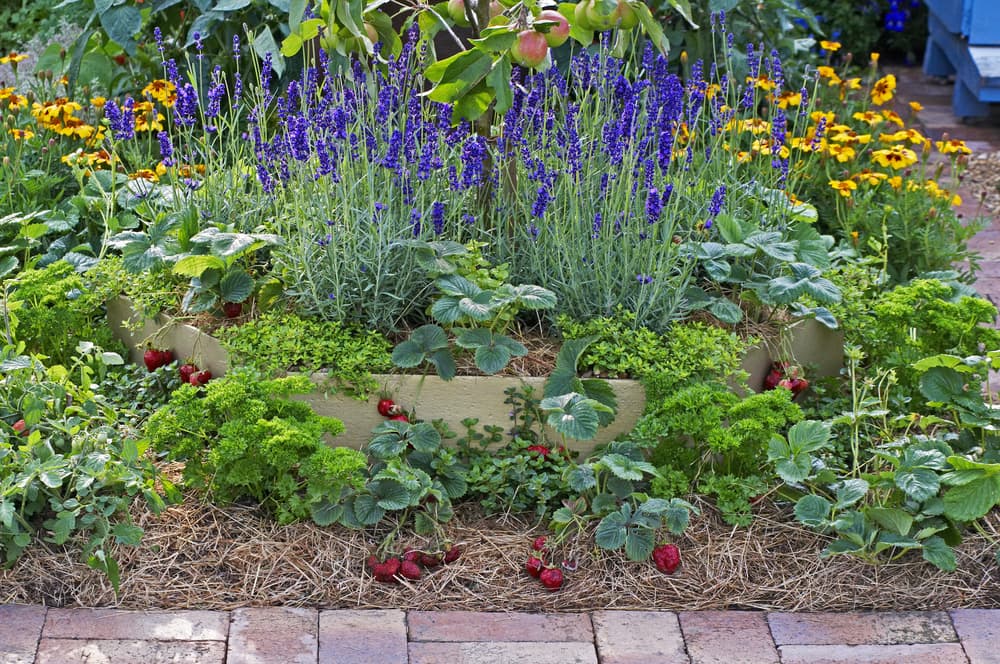
- BOTANICAL NAME: Lavandula angustifolia
- HARDINESS RATING: H5
- PLANT TYPE: shrub / herb
- FLOWERS: purple
- FLOWERING SEASON(S): summer
English lavender is famed for attracting bees and other pollinators, as anyone who has grown it can attest.
However, its aromatic qualities are also useful for deterring some pests that might otherwise munch on your veg; it is especially useful when planted next to brassicas (such as cabbage and broccoli) to deter pests such as cabbage white butterfly.
Lavender loves the sun and will do best when grown in a sheltered position with well-draining soil.
3) Sweet Pea

- BOTANICAL NAME: Lathyrus odoratus
- HARDINESS RATING: H3
- PLANT TYPE: annual / climber
- FLOWERS: purple, pink, red blue and white
- FLOWERING SEASON(S): summer / autumn
A nitrogen-fixing plant, Lathyrus odoratus, also known as sweet pea, is an annual shrub that will help brassicas and other leafy greens get the nutrients they need naturally.2Wagner, S. (2011). Biological Nitrogen Fixation. The Nature Education Knowledge Project. Retrieved March 15, 2023, from https://www.nature.com/scitable/knowledge/library/biological-nitrogen-fixation-23570419/
Sweet peas are also great plants for pollinators, producing purple flowers in the summer and autumn months, and can be grown against a trellis with climbing vegetables, like runner beans, that also like the same growing conditions.
4) Daisy
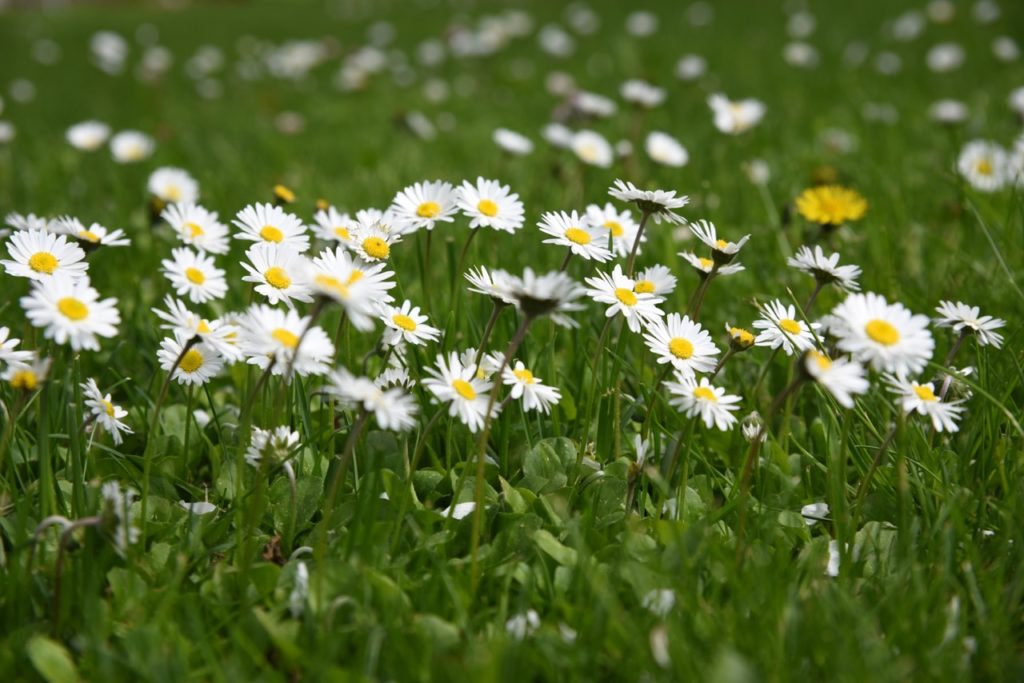
- BOTANICAL NAME: Bellis perennis
- HARDINESS RATING: H7
- PLANT TYPE: perennial
- FLOWERS: white and pink tinges with yellow centres
- FLOWERING SEASON(S): spring / summer
Daisies are a great choice for growing in your vegetable bed if you are limited in space.
Growing to only 10cm in height and spread, these tiny perennials can cope well in a range of conditions and will attract beneficial insects to the plants growing around them.
I’d recommend planting daisies around the base of your larger vegetables so they can also act as a ground cover plant and help deter weeds.
5) Thyme

- BOTANICAL NAME: Thymus vulgaris
- HARDINESS RATING: H5
- PLANT TYPE: shrub / herb
- FLOWERS: pink and white
- FLOWERING SEASON(S): summer
Thyme is a fragrant shrub that is said to help repel aphids, cabbage moths and other related pests from your brassicas.
However, there are another few reasons that you might consider growing thyme in your garden – one of them being that they can enhance the flavour of many of your vegetables.
This may be simply anecdotal, but when planted next to tomatoes, shallots, potatoes and many other delicious crops, thyme is said to improve the taste.
We’ll leave that for you to decide!
6) Cosmea
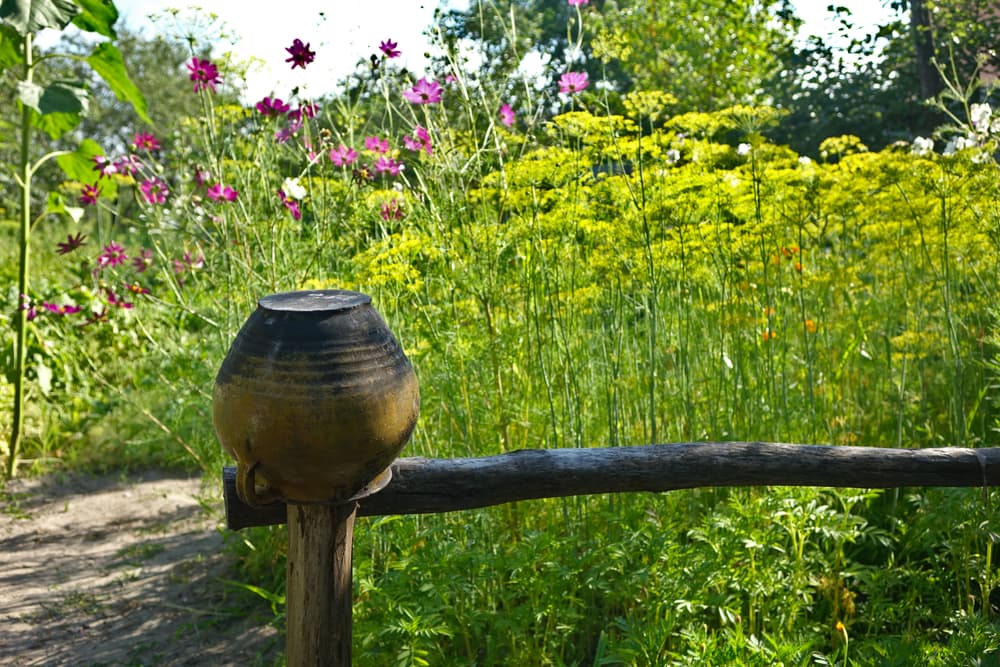
- BOTANICAL NAME: Cosmos bipinnatus
- HARDINESS RATING: H3
- PLANT TYPE: annual
- FLOWERS: white, red and pink
- FLOWERING SEASON(S): summer / autumn
With their white and pink fragrant flowers appearing throughout the summer and autumn months, cosmos are great companion plants for a range of vegetables.
By planting cosmos next to tomatoes, squash and a range of other vegetables, pollinators will frequent these plants too, resulting in a typically larger yield which can then be harvested readily.3Nicole, W. (2015). Pollinator Power: Nutrition Security Benefits of an Ecosystem Service. Environmental Health Perspectives, 123(8), 123–210. https://doi.org/10.1289/ehp.123-a210
If you fancy brightening up your vegetable plot, why not try planting cosmea next to some beetroots, as their brightly coloured blooms will stand out against the green and purple foliage of this commonly grown garden vegetable.
7) Marigold

- BOTANICAL NAME: Calendula officinalis
- HARDINESS RATING: H5
- PLANT TYPE: annual / biennial
- FLOWERS: orange
- FLOWERING SEASON(S): summer / autumn
Marigolds are a great plant for your vegetable garden for many reasons.
Like the others on this list, they are pollinator-friendly, but they are also effective plants for attracting pests like slugs and snails.
Feeding on marigolds keeps these pests well away from your leafy greens.
They are also relatively low-maintenance plants and can grow well in a range of conditions, so will be easily sown in garden beds with a range of different veggies.
8) Dwarf Perennial Lupin
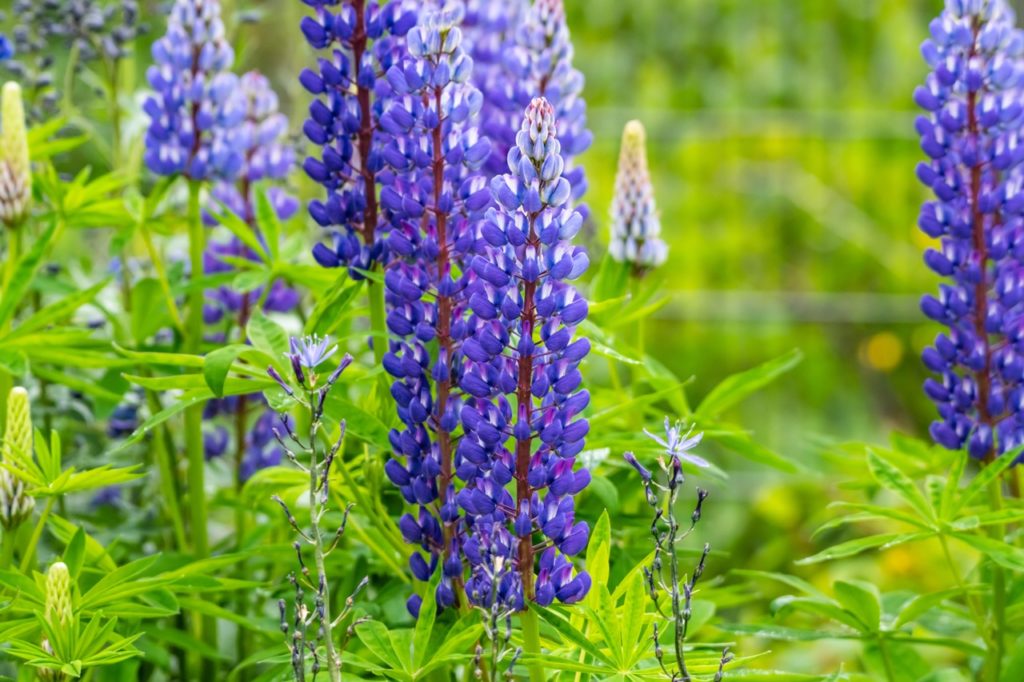
- BOTANICAL NAME: Lupinus nootkatensis
- HARDINESS RATING: H6
- PLANT TYPE: perennial
- FLOWERS: white, pink, purple and blue
- FLOWERING SEASON(S): summer
A member of the Legume genus, Lupinus nootkatensis is another nitrogen-fixing plant that will help the plants growing closest to it to grow.
Lupins are a great choice for short veggies that need some shade to grow best, such as lettuce – as their abundance of upright purple flowers and bushy green foliage can provide all the shelter they need.
I’ve chosen this specific dwarf variety of lupin because although it is 1.5m tall, it shouldn’t spread any further than 1m, leaving plenty of room in your vegetable beds for productive crops.
9) Fennel
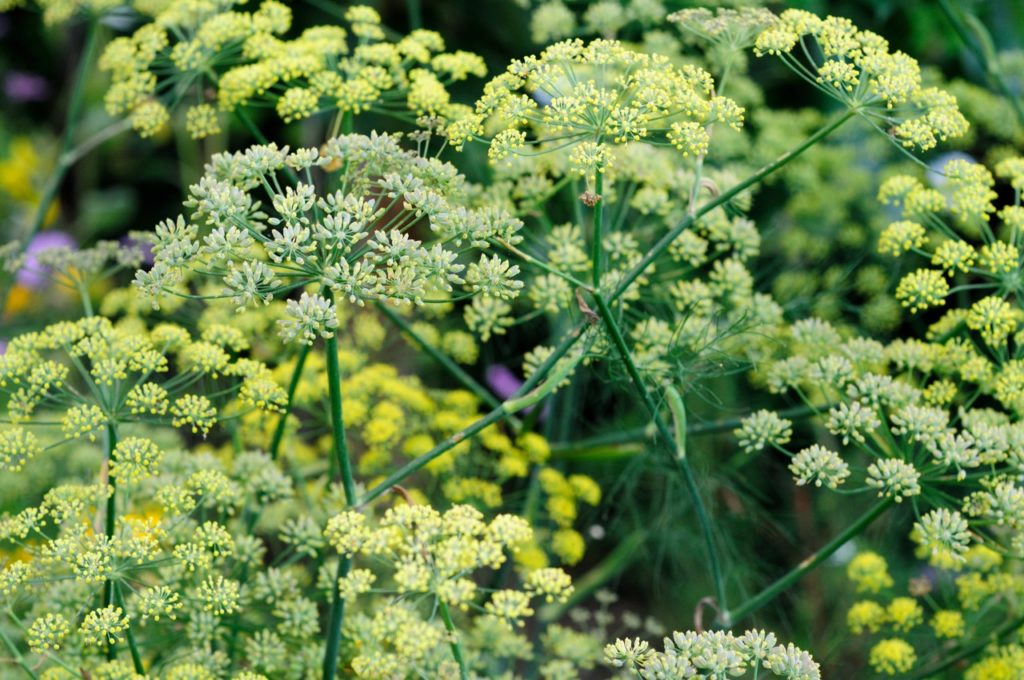
- BOTANICAL NAME: Foeniculum vulgare
- HARDINESS RATING: H5
- PLANT TYPE: perennial / herb
- FLOWERS: yellow
- FLOWERING SEASON(S): summer
Fennel is a perennial herb that is not usually recommended for companion planting at all.
However, it is an excellent pollinator and is good at repelling flies, particularly carrot flies that can damage the roots of carrots, parsnips and celery.4Carrot Root Fly. (n.d.). Bayer Crop Science UK. Retrieved March 15, 2023, from https://cropscience.bayer.co.uk/threats/pest-and-slugs/carrot-root-fly/
Do not let this plant go to seed, as it will germinate freely and can be a prolific spreader once established.
10) White Clover
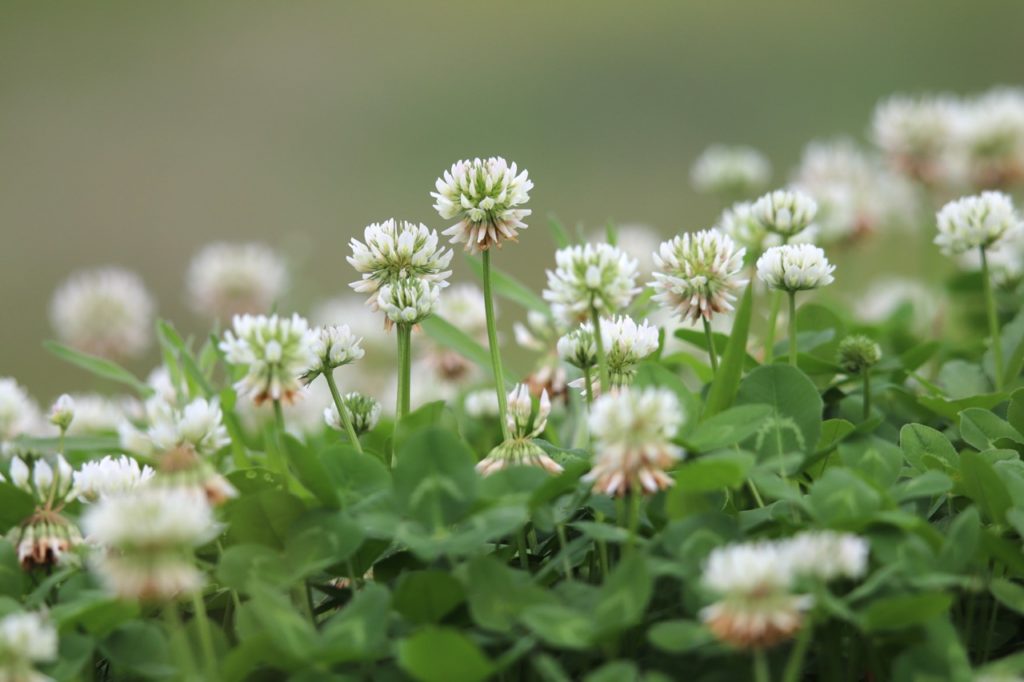
- BOTANICAL NAME: Trifolium repens
- HARDINESS RATING: H7
- PLANT TYPE: perennial
- FLOWERS: white and pink
- FLOWERING SEASON(S): spring / summer
White clover is most commonly planted in vegetable gardens as a living mulch that can prevent common weeds, retain moisture in the ground and fix nitrogen from the atmosphere, enriching the soil.5Mathieu, H., & Howatson, S. (2020, June 8). Using clover to drive performance with reduced Nitrogen inputs. AHDB. Retrieved March 15, 2023, from https://ahdb.org.uk/events/using-clover-to-drive-performance-with-reduced-nitrogen-inputs
Although it is technically a weed, this plant can also bring beneficial pollinators to your vegetable patch.
I’d recommend planting white clover after your vegetables are already established to prevent it stealing nutrients that might benefit your crops.
11) Borage

- BOTANICAL NAME: Borago officinalis
- HARDINESS RATING: H5
- PLANT TYPE: herb / annual
- FLOWERS: blue
- FLOWERING SEASON(S): summer
The leaves from borage, a relative of comfrey, can also be harvested and used in organic fertilisers, chopped and dropped directly onto the soil and grown as green manures.
It is said to grow well and benefit companion veggies that thrive in conditions with high levels of Potassium, such as peas, cucumbers and beans.6Diagnosing potassium deficiency in field peas. (2015, May 13). Department of Primary Industries and Regional Development: Agriculture and Food. Retrieved March 15, 2023, from https://www.agric.wa.gov.au/mycrop/diagnosing-potassium-deficiency-field-peas
12) Sunflower

- BOTANICAL NAME: Helianthus annuus
- HARDINESS RATING: H4
- PLANT TYPE: annual
- FLOWERS: yellow or red with brown centres
- FLOWERING SEASON(S): summer
Sunflowers are beloved by gardeners and pollinators, and they can be a treat in your vegetable patch too!
They are a great choice for planting alongside tall, climbing veggies like cucumbers, peas and corn that will need some support from stakes or a trellis when growing in your garden.
In fact, these vegetables can even grow around your sunflowers and assist in supporting each other as they both grow taller.
Not only that, you can harvest the sunflower seeds at the end of their flowering season and use them in your salads with the greens you’ve just grown them with.
13) Sweet Alyssum
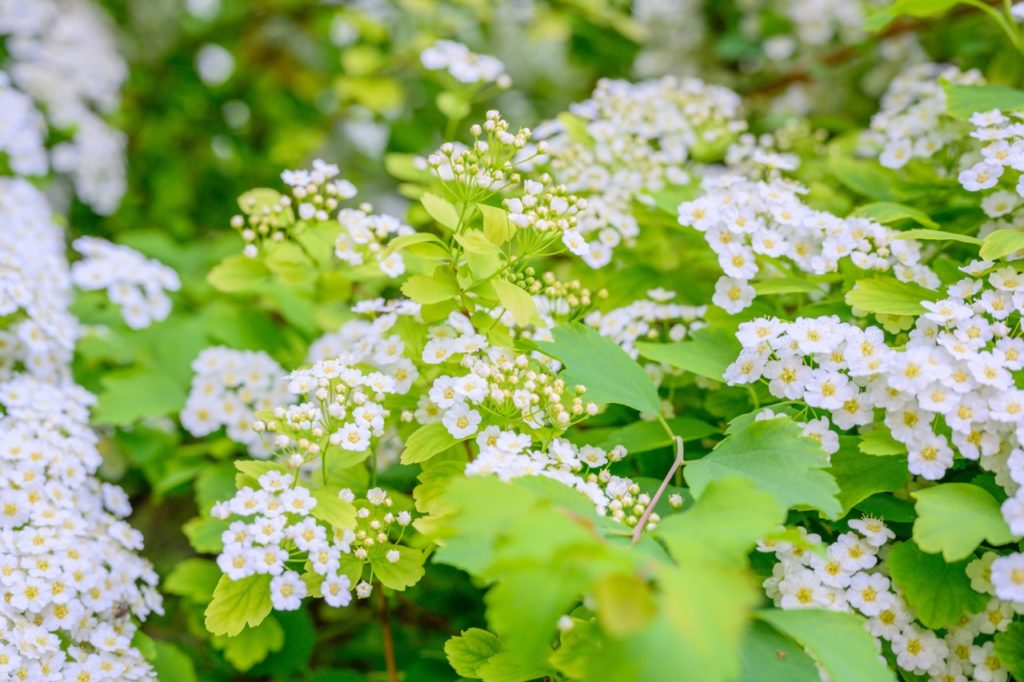
- BOTANICAL NAME: Lobularia maritima
- HARDINESS RATING: H3
- PLANT TYPE: annual / perennial
- FLOWERS: white
- FLOWERING SEASON(S): summer
If aphids are a problem in your vegetable patch, growing sweet alyssum nearby might be an easy fix.
This short-lived perennial produces clusters of white flowers that attract predatorial insects such as ladybirds – known for feeding on aphids and other pests.
With a single ladybird able to devour up to 50 aphids each day, your leafy greens should be safer and less likely to be targeted by these frustrating, sap-sucking pests.7Nair, A., & Mauch, T. (2022, January 31). Attract Beneficial Insects by Growing Sweet Alyssum. Iowa State University: Extension and Outreach. Retrieved March 15, 2023, from https://www.extension.iastate.edu/news/attract-beneficial-insects-growing-sweet-alyssum
14) Chamomile

- BOTANICAL NAME: Chamaemelum nobile
- HARDINESS RATING: H7
- PLANT TYPE: herb / perennial
- FLOWERS: yellow and white
- FLOWERING SEASON(S): summer
Chamomiles are not just attractive herbs – this hardy perennial attracts pollinators, enriches the soil with nutrients to encourage more rapid growth and can be used as ground cover to keep the soil moist.
Chamomile really is a delight for all of your leafy greens.
15) Garden Nasturtium

- BOTANICAL NAME: Tropaeolum majus
- HARDINESS RATING: H3
- PLANT TYPE: annual / climber
- FLOWERS: yellow, red and orange
- FLOWERING SEASON(S): summer / autumn
Tropaeolum majus, more commonly known as garden nasturtium, is commonly used as a companion plant in many garden displays.
However, you should also consider growing this colourful climber in your vegetable patches too.
Nasturtiums not only look lovely when planted in between rows of peppers, cucumber and leafy greens, but they can also act as a trap crop, luring slugs and snails to protect surrounding crops.
I have used this alongside many of my garden plants and it’s quite surprising how quickly the stems and foliage can attract and be covered by aphids.
Don’t let this put you off however – surrounding plants are usually completely ignored as this is a prized treat for many garden pests!
Hopefully, this list of 15 companion plants for your vegetable garden will have given you enough to work from – there are undoubtedly many more flowers that can add a whole host of benefits!
References
- 1Abel, A. (2020, May 22). How Permaculture Practices Can Help You Mentally and Physically During Isolation. The Permaculture Research Institute. Retrieved March 15, 2023, from https://www.permaculturenews.org/2020/05/22/how-permaculture-practices-can-help-you-mentally-and-physically-during-isolation/
- 2Wagner, S. (2011). Biological Nitrogen Fixation. The Nature Education Knowledge Project. Retrieved March 15, 2023, from https://www.nature.com/scitable/knowledge/library/biological-nitrogen-fixation-23570419/
- 3Nicole, W. (2015). Pollinator Power: Nutrition Security Benefits of an Ecosystem Service. Environmental Health Perspectives, 123(8), 123–210. https://doi.org/10.1289/ehp.123-a210
- 4Carrot Root Fly. (n.d.). Bayer Crop Science UK. Retrieved March 15, 2023, from https://cropscience.bayer.co.uk/threats/pest-and-slugs/carrot-root-fly/
- 5Mathieu, H., & Howatson, S. (2020, June 8). Using clover to drive performance with reduced Nitrogen inputs. AHDB. Retrieved March 15, 2023, from https://ahdb.org.uk/events/using-clover-to-drive-performance-with-reduced-nitrogen-inputs
- 6Diagnosing potassium deficiency in field peas. (2015, May 13). Department of Primary Industries and Regional Development: Agriculture and Food. Retrieved March 15, 2023, from https://www.agric.wa.gov.au/mycrop/diagnosing-potassium-deficiency-field-peas
- 7Nair, A., & Mauch, T. (2022, January 31). Attract Beneficial Insects by Growing Sweet Alyssum. Iowa State University: Extension and Outreach. Retrieved March 15, 2023, from https://www.extension.iastate.edu/news/attract-beneficial-insects-growing-sweet-alyssum

